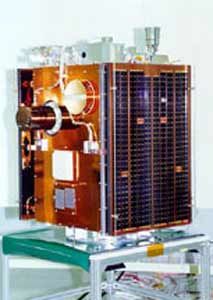
Home - Search - Browse - Alphabetic Index: 0- 1- 2- 3- 4- 5- 6- 7- 8- 9
A- B- C- D- E- F- G- H- I- J- K- L- M- N- O- P- Q- R- S- T- U- V- W- X- Y- Z
Kitsat
 Kitsat-3 Credit: Manufacturer Image |
AKA: Kaitsat. Status: Operational 1993. First Launch: 1993-09-26. Last Launch: 1999-05-26. Number: 2 . Gross mass: 50 kg (110 lb).
In August 1992 South Korea's first completely indigenous satellite was launched as a piggyback payload on the Topex/Poseidon mission. The 50-kg microsat was known variously as Kitsat 1, Oscar 23, and Uribyol 1 (Our Star).
The Kitsat-1 satellite's experimental payloads included:
Earth Imaging System (EIS) - The KITSAT-A EIS consisted of two charge-coupled device (CCD) imagers, two lenses, and a Transputer Image Processing Experiment. One of the imagers would provide a wide field of view with approximately 4km-ground resolution. The second imager would provide telephoto facility giving approximately 400 meters ground resolution.
Digital Signal Processing Experiment (DPSE) - The DPSE comprised two Texas Instruments DSP microprocessors which could work separately or in parallel. The DPSE would broadcast stored speech; relay compressed speech in real time; and implement advanced data link modulation techniques.
PACSAT Communications System (PCS) - The KITSAT-A PCS would provide store-and-forward digital communications for stations in the Amateur Satellite service. This system would use standard protocols for message forwarding. Storage would be in a 13 Mbyte CMOS SRAM bank.
Cosmic Ray Experiment (CRE) - KITSAT-A would continue the radiation environment and effects monitoring which was currently ongoing on the UoSAT-3 and UoSAT-5 satellites. A total dose experiment would measure total ionizing dose and a Cosmic Particle Experiment would monitor energetic particle events. The data collected from KITSAT-A's high-altitude, inclined orbit would be compared with that available in the 800-km polar orbits already monitored.
The collaboration has also encompassed the installation of ground station facilities in Korea, participation of Korean engineers in the UoSAT-5 mission, technology transfer and training of students on the MSc courses at Surrey.
More at: IRS-P4.
Family: Communications, Earth, Sun synchronous orbit, Technology, Technology satellite. Country: Korea South. Spacecraft: Oscar. Launch Vehicles: Kosmos 11K65M, Ariane, Ariane 40, PSLV. Launch Sites: Kourou, Sriharikota, Kourou ELA2, Sriharikota PSLV. Agency: KAIST. Bibliography: 2, 4, 6, 12733.
1993 September 26 - . 01:45 GMT - . Launch Site: Kourou. Launch Complex: Kourou ELA2. LV Family: Ariane. Launch Vehicle: Ariane 40.
- Kitsat-2 - .
Payload: Oscar 25. Mass: 49 kg (108 lb). Nation: Korea South.
Agency: KAIST.
Program: Oscar.
Class: Communications.
Type: Amateur radio communications satellite. Spacecraft: Kitsat.
USAF Sat Cat: 22825 . COSPAR: 1993-061C. Apogee: 801 km (497 mi). Perigee: 790 km (490 mi). Inclination: 98.30 deg. Period: 100.80 min.
KITSAT-OSCAR 25 was a South Korean experimental microsatellite based on the SSTL UoSAT bus built by the Korean Advanced Institute of Science and Technology (KAIST). KO-25 was operated from The Satellite Technology Research Center (SaTReC) in South Korea. KO-25's mission was to take CCD pictures, process numerical information, measure radiation, and receive and forward messages. The Infrared Sensor Experiment (IREX) was designed to acquire I/V characteristics of IR sensors. A passive cooling structure was devised for this experiment. KO-25 was eventually operated purely as a packet store-and-forward satellite.
1999 May 26 - . 06:22 GMT - . Launch Site: Sriharikota. Launch Complex: Sriharikota PSLV. Launch Vehicle: PSLV.
- Kitsat-3 - . Mass: 50 kg (110 lb). Nation: Korea South. Agency: ISRO. Manufacturer: KAIST. Class: Earth. Type: Seismology satellite. Spacecraft: Kitsat. USAF Sat Cat: 25756 . COSPAR: 1999-029A. Apogee: 727 km (451 mi). Perigee: 707 km (439 mi). Inclination: 98.60 deg. Period: 99.10 min.
Back to top of page
Home - Search - Browse - Alphabetic Index: 0- 1- 2- 3- 4- 5- 6- 7- 8- 9
A- B- C- D- E- F- G- H- I- J- K- L- M- N- O- P- Q- R- S- T- U- V- W- X- Y- Z
© 1997-2019 Mark Wade - Contact
© / Conditions for Use